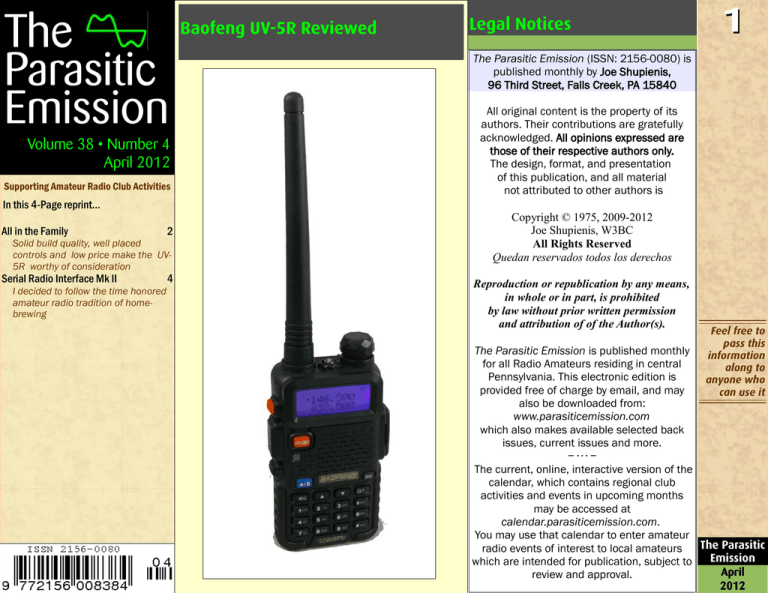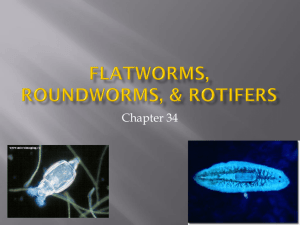
The
Parasitic
Emission
Volume 38 • Number 4
April 2012
Supporting Amateur Radio Club Activities
In this 4-Page reprint...
All in the Family
2
Serial Radio Interface Mk II
4
Solid build quality, well placed
controls and low price make the UV5R worthy of consideration
I decided to follow the time honored
amateur radio tradition of homebrewing
Baofeng UV-5R Reviewed
Legal Notices
1
The Parasitic Emission (ISSN: 2156-0080) is
published monthly by Joe Shupienis,
96 Third Street, Falls Creek, PA 15840
All original content is the property of its
authors. Their contributions are gratefully
acknowledged. All opinions expressed are
those of their respective authors only.
The design, format, and presentation
of this publication, and all material
not attributed to other authors is
Copyright © 1975, 2009-2012
Joe Shupienis, W3BC
All Rights Reserved
Quedan reservados todos los derechos
Reproduction or republication by any means,
in whole or in part, is prohibited
by law without prior written permission
and attribution of of the Author(s).
Feel free to
pass this
information
along to
anyone who
can use it
The Parasitic Emission is published monthly
for all Radio Amateurs residing in central
Pennsylvania. This electronic edition is
provided free of charge by email, and may
also be downloaded from:
www.parasiticemission.com
which also makes available selected back
issues, current issues and more.
−∙∙∙−
The current, online, interactive version of the
calendar, which contains regional club
activities and events in upcoming months
may be accessed at
calendar.parasiticemission.com.
You may use that calendar to enter amateur
The Parasitic
radio events of interest to local amateurs
Emission
which are intended for publication, subject to
April
review and approval.
2012
case, you can go ahead
and feel lucky!
I ordered mine from
“nicheone” on Ebay, and it
arrived in three days from
China! The expedited
shipping was free at that!
It comes in a larger,
heavier box than the UV3R, so if nothing else, you
know you're getting more
“stuff” in this deal. Inside
that box are two trays
holding all the pieces,
stacked one above the
other. Included is a
readable manual I pretty
passable English.
The most noticeable item
in the box is the docking
charger stand. Along with
its matching “wall-wart”
power supply, the charger
is a true drop-in unit, and
All in the Family
charges one battery pack, separately or
by Joe Shupienis W3BC attached to the radio. It even provides
ast month we looked at a entertainment value when you attempt to
read the “Engrish” label on the bottom! (May
tiny wonder from China called the
you never suffer the perils of the dreaded
Baofeng UV-3R. It enjoys a welldeserved reputation of providing a lot of bang “chareto mistake!”)
for the buck, and indeed, it is a remarkable
The Good
little radio. They're literally selling like
he battery pack is a 7.4hotcakes and more as more hams find a use
volt, 1800mAH, custom unit
for a bargain-priced dual-band HT.
designed to fit the UV-5R like a
After seeing how delightfully well the little guy glove. It slides onto the back of the radio, and
performs, I had to see if big brother lives up to secures with a solid click ensuring it stays
its promise. So I ordered a Baofeng UV-5R. At put. I've run the radio for over a day at a time
a street price of just $60, it seems almost
on a single charge without running low, and
impossible that for a few dollars more it could the unit charges in about an hour or less.
be significantly better than the $46 kid
There are many notable differences between
brother, but as we will see, you pay your
the UV-5R and its kid brother. The UV-5R's
money and you take your chances. In this
single knob is an old-school, volume control
L
T
with a ganged power switch! That's right, turn
the knob to turn the radio on and set the
volume, just like a 1950s TV set!
2
The antenna connector is not the “standard”
SMA connector. For some inscrutable reason,
Baofeng chose to use the bass-ackwards,
Wouxun-style SMA connector. Adapters are
cheaply available—there's even one at Radio
Shack for $6—but why they did this is a
mystery to me! At least the supplied dualband rubber duck antenna is a good one.
Moving from the top of the radio to the front,
we start to see where the UV-5R leaves its
baby brother in the dust. The display is
noticeably different, The dot-matrix LCD is
backlit by your choice of orange, blue or violet
LEDs. It's also an alpha-numeric display, and
allows you to enter channel names in letters
and numbers—up to six characters each—but
only through the programming software.
The speaker and mic grille is immediately
below the display, and the audio sounds very
crisp and clean, if a bit on the loud side. The
laser-etched metal nameplates add a
professional touch. In hand, the whole radio
feels solid and professional, unlike the
somewhat “flexy” plastic feel of the UV-3R.
Solid build
quality, well
placed
controls and
low price
The most outstanding feature is the numeric
make the
keypad, which is very elegantly backlit with
UV-5R
white LEDs to just the right brightness. The
worthy of
keypad is used to directly enter frequencies or consideration
channel numbers, or to use “Touchtone™”
signaling when transmitting. Additionally, the
most common menu items can be selected by
pressing the buttons as marked in blue. The
overall impression of the radio is one of
quality, which makes its tiny $60 price tag
almost unbelievable.
If the proof is in the putting, this unit delivers. The Parasitic
I measured 5.2 watts on VHF and 4.4 on UHF
Emission
into a 50Ω load. Low power was inconsistent—
April
one time it was 2.2 watts, another 0.7, and
2012
something in between another time. This may
have been due to me enabling the automatic
power control feature. More research is
indicated
see a lot!. I'm being way too kind when I say
that the BF5R.exe program is just barely
enough to get the job done. It looks like POC
software—as in ”Proof of Concept” (you know
what I really mean!) Fortunately, once you
On the air, all reports are that the rig has
program the radio, you don't have to suffer
good audio, as long as I hold it up to my
mouth. The tiny mic opening does not do very through using the software ever again. With
universal dislike of the software being voiced
well at a distance. This may be a design
all over the Internet, it's only a matter of time
feature to permit “noise canceling” in
industrial environments. At full volume, its tiny until the manufacturer comes up with a
finished product, or the Open Source “CHIRP”
speaker is more than capable of getting you
project gains the ability to manage the UV-5R.
kicked out of a boiler factory for making too
much noise.
The UV-5R features a Kenwood-style speakerReceiver sensitivity is quite good. Like it's UV- mic connector on the right side, which
3R sidekick, it's rated at 0.2μV/12 dB SINAD. doubles as the programming port. This is
completely different from the UV-3R's single
The UV-5R's DSP circuitry really delivers the
jack which uses the less-common TRRS,
goods and pulls out the weakest of weak
“Three Circuit” 1/8” connector for its speakersignals with Q5 readability. Spurious
mic and programming port.
responses appear to be under control, and
the direct conversion SDR design means no
“image” problems and makes intermod a
thing of the past. Front end overload is still
possible, but the DSP derived AGC seems to
do an adequate job.
There are 128 programmable channels, and
each one retains individual data fields for
receive frequency, transmit
frequency, tone encode/decode,
wide/narrow deviation, high/low
power, PTT ID, Busy-channel lockout,
scanning lockout, call-group ID, and
alphanumeric channel name. This
gives the radio a lot of flexibility,
rivaling units at 4 or 5 times the
price.
The Bad
M
anaging all
that data is
handled by the worst
piece of software I have ever seen—
and when I first used computers
they needed punched cards, so I've
The Ugly
W
ith apologies to Clint
Eastwood, a ham's got to know
his limitations, and this radio
certainly has some. Fortunately, none of them
are show stoppers, and when you see this
radio on your doorstep, it will definitely make
your day! Nothing is perfect, though, and here
are my main beefs with it:
#1: As already covered, the
biggest issue for me is the
crummy programming software.
This is something the
manufacturer can easily fix, but it
remains to be seen if they do.
CHIRP now has support, so things
are looking up!
bit “odd” requiring separate steps to program
transmit and receive frequencies for
repeaters. The radio does not have
convenience features like automatic repeater
split built in. (To be fair, I have yet to see ANY
rig with automatic repeater split that works
100% with the Western PA Repeater Council's
Bandplan!)
3
#4: A further complaint is that even the
lowest volume setting is too loud. Sixty years
ago, the old '50s TV sets completely muted
when turned all the way down, but retro-style
volume knob notwithstanding, the UV-5R is
almost always “too loud.”
#5: Finally, after the rig warms up from
extended transmitting, the LCD display
becomes harder to read due to heat-related
loss of contrast. There is no contrast setting,
so you have to wait for the unit to cool a little
to regain contrast in the display.
The Bottom Line
A
s I stated, none of these are
serious limitations, and most of the
Solid build
time, they won't get in your way. The quality, well
excellent RF performance provided by this
placed
Software Defined Radio's Digital Signal
controls and
Processing, it's solid build quality, well placed
low price
make the
controls and it's low price make the Baofeng
UV-5R
UV-5R a handheld transceiver worthy of
worthy of
consideration. At half the price of it's nearest
competitors (the Wouxun dual band radios) its consideration
price/performance ratio leads the pack.
Like its kid brother the UV-3R the mid-size UV5R is a significant entry in the full-feature
handheld market. Big Brother continues the
family tradition of providing plenty of bang for
#2: Coming in at number
the buck. Whether you're looking for an extra
two on my list is the “bass- HT to keep in the car, or you figure it's about
ackwards™” antenna
time you got on the UHF repeaters, this radio The Parasitic
connector.
deserves a place on the short list of every
Emission
ham
who
is
looking
for
a
good
HT
at
a
April
#3: Manual programming is a
reasonable price.
2012
transistor receives TTL 0 (0v) and 1 (>3.5v)
and switches between saturation and cutoff
Serial Radio Interface Mk II
decided to follow the time
to switch the RS-232 RxD line from +6 to 0
honored amateur radio tradition of
by Joe Shupienis W3BC
volts which while not technically “correct” is
homebrewing, and scoured the Internet an acceptable level transition for modern
hen I received my new
to find a circuit. There were several, but they computers with UARTs.
Baofeng UV-5R, I found that I
weren't specifically designed for this radio.
needed to add the correct
Pullup voltage is obtained by rectifying the +6
I finally decided that I'd be better off designconnectors to the interface circuit described
volts from the pin 4 DTR signal from the
ing one from the ground up. (Pun not intend- computer and building up a charge in the
in last month's issue (at right).
ed!) I started by identifying what the circuit
22uF capacitor. The voltage is stabilized and
I put a little more thought into the design, and had to do: convert the RS-232 +6v and -6v
converted to the appropriate level by the 180split it at the “breakout points” A, B and C.
levels to the +3.5v and 0v CMOS logic levels ohm and 2.2 K resistors.
Connections are made to the corresponding
the radio uses, and run under its own power.
pins on the radio-specific plugs, and it works
The 10K resistor between DB-9 Pin 3 and the
Another design criterion I prefer to use is that base of the transistor is optional. My unit
just fine.
all the parts should be available locally. After works better with it, but you may not need it.
all, what's the point of building one if you can
order a ready-made unit and receive it sooner On the Job
—and cheaper—than your parts order from
This simple circuit works very reliably. It
DigiKey or Mouser?
transfers the entire memory contents of the
Original Article
W
I
Radio Shack still stocks NPN switching
transistors, small signal diodes, resistors and
capacitors, perf-boards and DB-9 connectors,
so there were almost all the parts waiting just
a couple miles away. The only “exotic” part
was the 4-terminal 1/8 inch audio plug. I dug
up an old cellphone headset which used that
plug, and after determining I had no further
use for it (it wasn't wired correctly to use it as
a speaker-mic for the radio), I cut the cord
about a foot from the end and prepped it.
radio in seconds. After all that programming,
you feel a sense of relief, knowing you can
restore those settings in a few seconds,
should your ever “misprogram” the radio.
Now, it was simply a matter of laying out the
parts on the perf-board, and soldering
everything together.
to remove the antenna, close the squelch and
be careful not to transmit.
Circuit Description
“The nice thing about standards is that you
have so many to choose from.”
– Andrew S. Tanenbaum, PhD.
My level converter uses the switching
transistors as switches—when the input logic
from the computer goes from 0 (+6 volts) to 1
(-6 volts) the transistor goes from saturation
to cutoff, and goes from TTL 0 (0 v) to TTL 1
(>3.5v) and sends the signal to the radio at
the proper voltage level. Similarly, the other
4
The manufacturer's software as well as the
open-source “CHIRP” program both work
flawlessly with this interface.
I decided to
follow the
time honored
amateur
The only time it didn't work for me was when
radio
the radio was receiving a signal. The received
tradition of
audio confuses the program, and it reports
homebrewing
that the serial port is “not found.” The cure is
See More PE
by Joe Shupienis W3BC, Publisher
All recent editions of The Parasitic Emission
are available for free at parasiticemission.org.
The Parasitic
To subscribe to this monthly, multi-club
newsletter, send an email to:
Emission
subscribe@parasiticemission.com
April
2012




